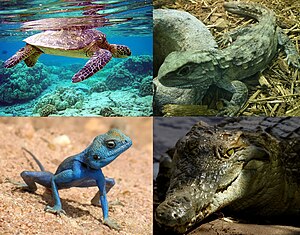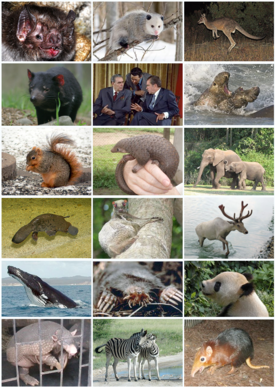Anatomy
The anatomy lesson of Dr. Nicolaes Tulp by Rembrandt shows an anatomy lesson taking place in Amsterdam in 1632
Michiel Jansz van Mierevelt – Anatomy lesson of Dr. Willem van der Meer
Anatomy is a part of biology and medicine that studies the structure of living things. Anatomy in general term includes human anatomy, animal anatomy (zootomy), and plant anatomy (phytotomy). In some of its aspects anatomy is closely related to embryology (science of the development of an embryo from the fertilization of the ovum to the fetus stage), comparative anatomy and comparative embryology, through common roots in evolution.
Anatomy is subdivided into gross anatomy (or macroscopic anatomy) and microscopic anatomy. Gross anatomy is the study of anatomical structures that can, when suitably presented or dissected, be seen by unaided vision with the naked eye. Microscopic anatomy is the study of minute anatomical structures on a microscopic scale. It includes histology (the study of tissues), and cytology (the study of cells). The terms microanatomy and histology are also sometimes used synonymously (in which case the distinction between histology and cell biology isn't strictly made as described here).
The history of anatomy has been characterized, over time, by a continually developing understanding of the functions of organs and structures in the body. Methods have also improved dramatically, advancing from examination of animals through dissection of cadavers (dead human bodies) to technologically complex techniques developed in the 20th century including X-ray, ultrasound, and MRI.
Superficial anatomy:
Superficial anatomy or surface anatomy is important in anatomy being the study of anatomical landmarks that can be readily seen from the contours or the surface of the body. With knowledge of superficial anatomy, physicians or veterinary surgeons gauge the position and anatomy of the associated deeper structures. Superficial is a directional term that indicates one structure is located more externally than another, or closer to the surface of the body.Animal anatomy:
- Insect anatomy:
Insect morphology
Legend of body parts
Tagmata : A - Head, B - Thorax, C - Abdomen.
|
1. antenna
|
17. anus
|
|
2. ocelli (lower)
|
18. oviduct
|
|
3. ocelli (upper)
|
19. nerve chord (abdominal ganglia)
|
|
4. compound eye
|
20. Malpighian tubes
|
|
5. brain (cerebral ganglia)
|
21. tarsal pads
|
|
6. prothorax
|
22. claws
|
|
7. dorsal blood vessel
|
23. tarsus
|
|
8. tracheal tubes (trunk with spiracle)
|
24. tibia
|
|
9. mesothorax
|
25. femur
|
|
10. metathorax
|
26. trochanter
|
|
11. forewing
|
27. fore-gut (crop, gizzard)
|
|
12. hindwing
|
28. thoracic ganglion
|
|
13. mid-gut (stomach)
|
29. coxa
|
|
14. dorsal tube (Heart)
|
30. salivary gland
|
|
15. ovary
|
31. subesophageal ganglion
|
|
16. hind-gut (intestine, rectum & anus)
|
32. mouthparts
|
Insects possess segmented bodies supported by an exoskeleton, a hard-jointed outer covering made mostly of chitin. The segments of the body are organized into three distinct parts, a head, a thorax and an abdomen. The head typically bears a pair of sensory antennae, a pair of compound eyes, one to three simple eyes (ocelli) and three sets of modified appendages that form the mouthparts. The thorax has three pairs of segmented legs, one pair each for the three segments that compose the thorax and one or two pairs of wings. The abdomen is composed of eleven segments, some of which may be fused and houses the digestive, respiratory, excretory and reproductive systems. There is considerable variations between species and many adaptations to the body parts, especially wings, legs, antennae and mouthparts.
- Vertebrate anatomy:
Fossilized skeleton of Diplodocus carnegii, showing an extreme example of the backbone that characterizes the vertebrates. Exhibited at the Museum für Naturkunde (Museum of Natural Science), Berlin.
Vertebrates include the overwhelming majority of the phylum Chordata, with currently about 64,000 species described. Vertebrates include the jawless fish, bony fish, sharks and rays, amphibians, reptiles, mammals, and birds. Extant vertebrates range in size from the frog species Paedophryne amauensis, at as little as 7.7 mm (0.3 inch), to the blue whale, at up to 33 m (110 ft). Vertebrates make up about 4% of all described animal species; the rest are invertebrates, which lack backbones.
1) Bird anatomy:
External anatomy (topography) of a typical bird: 1 Beak, 2 Head, 3 Iris, 4 Pupil, 5 Mantle, 6 Lesser coverts, 7 Scapulars, 8 Coverts, 9 Tertials, 10 Rump, 11 Primaries, 12 Vent, 13 Thigh, 14 Tibio-tarsal articulation, 15 Tarsus, 16 Feet, 17 Tibia, 18 Belly, 19 Flanks, 20 Breast, 21 Throat, 22 Wattle, 23 Eyestripe
The feathers are outgrowths of the epidermis. Large flight feathers are found on the wing and tail, contour feathers cover the bird's surface and fine down occurs on young birds and under the contour feathers of water birds. There are scales on the legs and feet and claws on the tips of the toes.
2) Reptile anatomy:
Clockwise from above left: Green turtle (Chelonia mydas), tuatara (Sphenodon punctatus), Nile crocodile (Crocodylus niloticus), and Sinai agama (Pseudotrapelus sinaitus)
Traditionally, reptiles are members of the class Reptilia comprising the amniotes that are neither birds nor mammals. (The amniotes are the vertebrates with eggs featuring an amnion, a double membrane that permits the embryo to breathe effectively on land.) Living reptiles, in that sense, can be distinguished from other tetrapods in that they are "cold-blooded" (poikilothermic) and bear scutes or scales.
3) Fish anatomy:
Skeleton of a butterfly fish showing the vertebral column and fin rays
The body of a fish is divided into a head, trunk and tail, although the divisions between the three are not always externally visible. The skeleton, which forms the support structure inside the fish, is either made of cartilage (cartilaginous fish) or bone (bony fishes). The main skeletal element is the vertebral column, composed of articulating vertebrae which are lightweight yet strong. The ribs attach to the spine and there are no limbs or limb girdles. The main external features of the fish, the fins, are composed of bony spines and soft rays and, with the exception of the caudal fins, have no direct connection with the spine. They are supported by the muscles which compose the main part of the trunk.
4) Mammal anatomy:
Examples of various mammalian orders, click the image and scroll down for individual descriptions
- Human anatomy:
Para-sagittal MRI scan of the head
An X-ray of a human chest
Human heart and lungs, from an old edition of Gray's Anatomy
Human anatomy, including gross human anatomy and histology, is primarily the scientific study of the morphology of the adult human body. It differs from Physiology in that Anatomy is only the structures involved, and Physiology is the way those structures actually work.
Generally, students of certain biological sciences, paramedics, prosthetists and orthotists, physiotherapists, occupational therapists, nurses, and medical students learn gross anatomy and microscopic anatomy from anatomical models, skeletons, textbooks, diagrams, photographs, lectures and tutorials, and in addition, medical students generally also learn gross anatomy through practical experience of dissection and inspection of cadavers. The study of microscopic anatomy (or histology) can be aided by practical experience examining histological preparations (or slides) under a microscope.
Human anatomy, physiology and biochemistry are complementary basic medical sciences, which are generally taught to medical students in their first year at medical school. Human anatomy can be taught regionally or systemically; that is, respectively, studying anatomy by bodily regions such as the head and chest, or studying by specific systems, such as the nervous or respiratory systems. The major anatomy textbook, Gray's Anatomy, has recently been reorganized from a systems format to a regional format, in line with modern teaching methods. A thorough working knowledge of anatomy is required by physicians, especially surgeons and doctors working in some diagnostic specialties, such as histopathology and radiology.
Academic human anatomists are usually employed by universities, medical schools or teaching hospitals. They are often involved in teaching anatomy, and research into certain systems, organs, tissues or cells.
Plant anatomy:
Plant anatomy involves the structure of the cells, in contrast to animal cells. Plant cells have cell walls, chlorophyll, and lack mitochondria. They also contain larger reservoirs called Lysosomes. Plant lack the digestive organs common among animals because they create their own energy from the sun, in photosynthesis. This makes them more independent and also a source of energy for other animals.Other branches:
- Comparative anatomy relates to the comparison of anatomical structures (both gross and microscopic) in different animals.
- Anthropological anatomy or physical anthropology relates to the comparison of the anatomy of different races of humans.
- Artistic anatomy relates to anatomic studies for artistic reasons.








.gif/220px-Parasagittal_MRI_of_human_head_in_patient_with_benign_familial_macrocephaly_prior_to_brain_injury_(ANIMATED).gif)









0 comments:
Post a Comment